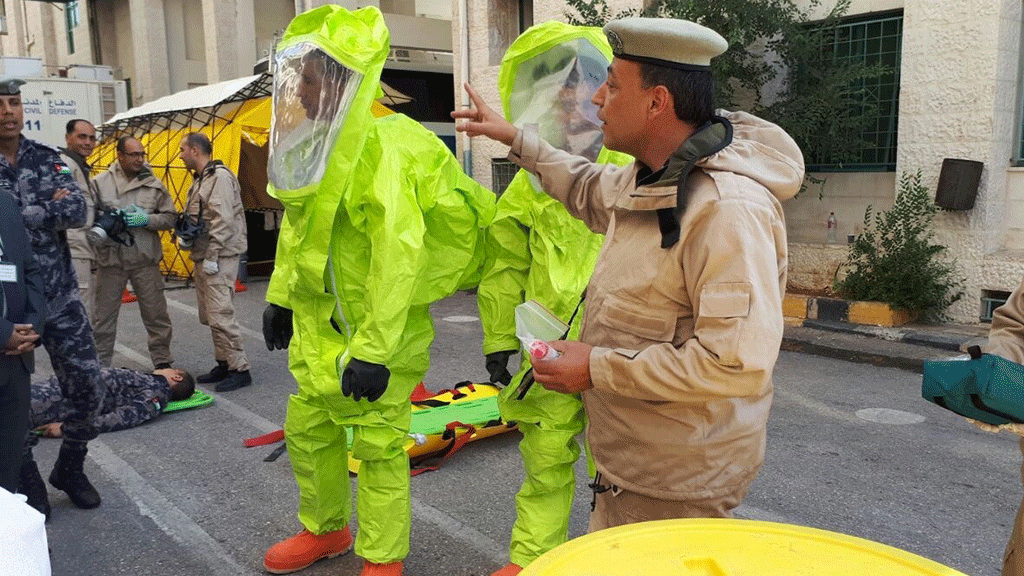Building Nuclear Forensics Capacity in Armenia

“Nuclear terrorism” is among the most fear-inducing phrases one can hear or read. Both print and electronic media are saturated with news articles, think tank analyses, and opinion pieces discussing the threat posed by, and the potential impact of, a nuclear device falling into the hands of a non-state actor.
Garnering less press, however, is the much more likely event of an incident of radiological terrorism, distinguished by its use of non-fissile but still radioactive material. Radiological terrorism refers to substances slightly less-known than the infamous uranium or plutonium, instead involving isotopes such as cesium-137, strontium-90, and cobalt-60, all of which can be found in devices regularly used in the healthcare and industrial sectors. These materials, combined with a small amount of conventional explosives, could be used to create a Radiological Dispersal Device (RDD), otherwise known as a “Dirty Bomb.” Such a device has the potential to cause serious injuries and illness as well as untold economic costs in cleanup and decontamination.
In most developed nations, these radioactive sources are kept under strict control with extensive licensing procedures to ensure that they never fall into the wrong hands. Unfortunately, the risk of loss or theft of material still exists, and is even more pronounced in states with inadequate legal frameworks and loose regulatory oversight. The International Atomic Energy Agency (IAEA) maintains a database of events involving nuclear and other radioactive material outside of regulatory control. This Incident and Trafficking Database truly puts the radiological threat into perspective; according to a 2016 fact sheet, the ITDB tracked 2,889 incidents from 1993-2015. Of these incidents, 1,216 were categorized as “unauthorized possession and related criminal activities” or “theft or loss.” Of this 1,216, only 28 involved highly enriched uranium (HEU) or plutonium, while the rest were made up of radiological sources, many of which would likely be useful in an RDD.
Radioactive Waste. Pixabay.com
Sifting through publicly available accounts of these incidents shows a clear geographic concentration in the states of the former Soviet Union. These states face increased nuclear smuggling risks, an unfortunate result of limited economic opportunities motivating potential traffickers and challenges with enforcement. Georgia has the dubious distinction of being the site of a number of smuggling incidents, including one just last year when authorities arrested three men attempting to sell a sample of cesium-137 for $100,000.
Fortunately, some smugglers are caught using radiation portal monitors, provided by the United States, strategically positioned in locations such as border crossings.
These monitors are effectively worth their weight in gold, as they recently proved in a number of incidents involving Armenian smugglers using Georgia as a transshipment point. Three incidents in the last three years saw groups of Armenians transporting radioactive material through Georgia; cesium-137 was the material in two of these events, while the third was uranium-238. The majority of these suspects were “pensioners in their mid-70s” who “needed more money to live on.” With these incidents in mind, the United States, with the help of CRDF Global, is increasing cooperation with the Post-Soviet states to build their capacity to respond to nuclear smuggling and related incidents. The main goal of this effort is the establishment of a National Nuclear Forensics Lab based in Metsamor, Armenia, at the country’s only nuclear power plant.
Nuclear forensics, as defined by the IAEA, is “the examination of nuclear and other radioactive materials using analytical techniques to determine the origin and history of this material in the context of law enforcement investigations or the assessment of nuclear security vulnerabilities.” In other words, the techniques applied in a nuclear forensics laboratory can potentially be used to identify the origin of radioactive material, yielding information that is valuable to law enforcement investigations. Further, this information is useful not only in smuggling cases, but also in the aftermath of a potential dirty bomb event. Knowing the potential origin of the material used or recovered likely will not immediately identify a suspect, but it will give investigators a starting point which may eventually lead to an arrest.
Of course, the establishment of a facility is only half the battle. The nuclear forensics laboratory can only be effective if it is operated by a qualified nuclear technical workforce. Armenia’s experts are leading a proactive initiative to engage with foreign partners, namely the U.S. government and CRDF Global, to help sustain its capacity to conduct nuclear forensic analysis.
CRDF Global is working closely with both the U.S. Department of State’s Office of Weapons of Mass Destruction Terrorism and Armenian stakeholders to identify the current needs of the country’s workforce with regard to its nuclear forensics capability.
One challenge in this effort is that, while nuclear forensic analysis is extremely important, very few states will ever experience enough nuclear-related incidents to sustain a full time nuclear forensics expert. For this reason, it is necessary that nuclear forensics is framed as a special qualification for professionals employed in the nuclear field, rather than as an all-encompassing career. This makes the identification of a target audience for nuclear forensics expertise development relatively straightforward. The nuclear professionals already exist; the challenge lies in designing the most effective training and educational programs to prepare current and future professionals to utilize their skills to conduct nuclear forensic analysis within the context of a wider investigation.
Programs such as the expertise development project in Armenia will help develop technical proficiency as well as the proper procedures for generating and utilizing nuclear forensics evidence in the courtroom. This project will help ensure that the nuclear forensics professionals in Armenia are equipped with the tools and training they need to assist with investigations of nuclear and radiological smuggling activities.



